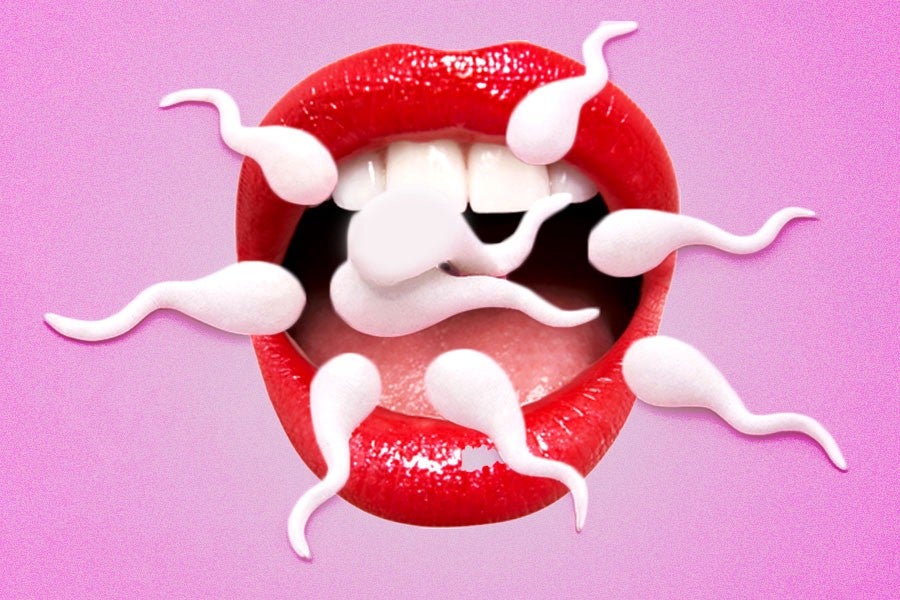Your sperm wasn’t built for this world, its lifespan mostly cut short by the elements. And even if it does make its way inside of a woman’s body to make that long and arduous journey, it’s still only got around a one in 200 million shot at actually fertilizing the egg (assuming that any of the sperm from that round make it that far).
Still, not all semen depositories are equally fatal for said splooge. Here’s a rundown of how long your sperm will last in the most common places it’s likely to end up.
Sperm Inside the Uterus
There’s no better environment for sperm’s survival — other than inside of a man’s own testicles, where sperm can live for up to 74 days — than inside of a woman’s body. More specifically, inside of a woman’s uterus where, on average, sperm can last for up to two days (even though thousands upon thousands will die upon entering a woman’s body). According to the American Pregnancy Association, in fact, during ovulation — when the vagina’s climate is especially moist and warm — sperm can survive for up to five days. “This usually happens when there’s enough cervical fluid or mucus to provide the sperms with nutrition — that is closer to ovulation,” reports the mom health site Cure Joy. “But, in very rare cases, if they end up in the right place — like the fallopian tubes — they can live as long as seven days.” Sadly, this is the longest lifespan your ejected sperm can hope for.
Sperm Inside the Mouth
Last year, Twitter user @_MariahV_ tweeted this:
So today in lab we swabbed inside our mouth to see bacteria under a microscope and a girl had a WHOLE LIVE SPERM in her microscope slide
— League Sources (@MARIAH_LEBRON) August 28, 2017
And while that does seem like the makings of a horror-porn flick — or at least a fairly robust Snopes entry — it turns out that, theoretically, it’s entirely possible (if admittedly unlikely), since the inside of a human mouth is a fairly ideal environment for sperm to survive in (i.e., warm and wet).
“If you’re talking about the science behind it, the temperature of the mouth is warmer than outside the body, and it’s a mucosal substance with gums, nooks and crannies,” Brian Steixner, a urologist and director of the Institute of Men’s Health at Jersey Urology Group, told Men’s Health. “In theory, it’s 100 percent reasonable that a sperm from oral sex in someone’s mouth could be alive the day after, assuming it’s Monday, or two days later.” Board-certified urologist Jamin Brahmbhatt agrees, adding that what we know about vaginal tissue can be generalized to include oral tissue.
Sperm on the Skin
Say you decide to finish on, rather than in, your partner — what then? By several measures, according to Brahmbhatt, sperm can only survive outside the body for a few minutes. But that survival time varies greatly depending on the surface or environment it lands on. According to Health Central, semen that’s close to the vagina — where again, the environment is likely to be warm and moist — can live for up to 20 minutes, which is yet another reason the pull-out method of birth control works only 80 percent of the time all the time. The same can be said for any and all other moistened skin surfaces, from sweat-drenched breasts to clammy palms.
Sperm in the Bath
According to Brahmbhatt, moistness is, again, the reason sperm can last a bit longer in a tub of warm water than on a dry surface. “Sperm likes warm and moist environments,” says Brahmbhatt. The good news — if you’re sharing that tub with a partner — is that the ratio of water to sperm makes it very unlikely the sperm will lead to a pregnancy. “Besides, any chemicals, soap or suds in the water are likely to kill the sperm,” reports Health Central.
Unless, of course, your partner decides to physically open herself up, writes Dr. Ruth in her response to one woman’s question on whether it’s possible to get pregnant from her boyfriend’s ejaculate in bathwater. “The danger of causing an unintended pregnancy from sperm released into bath water, or the water of a pool or hot tub, is very small as long as neither of you pries open the lips of your vagina,” she writes.
On a related note, there’s also the question of why bathwater — or any type of water (hot tub fans), for that matter — changes the viscosity of your semen, causing it to become gelatinous and clumped together. Per Medical Daily, it has to do with two proteins (semenogelin — a type of coagulation protein — and prostate solution antigen (PSA) — a dissolving protein) in your semen, which help protect your sperm through its journey inside the vagina. “Scientists hypothesize that water interferes with PSA’s ability to break down the coagulation properties of semenogelin,” reports Medical Daily. “As a result, without PSA, the semen gets sticky.”
Sperm on Hair, Sheets, Tissues, Carpets, Drapes, the Floor of Your Uber and Anywhere Else It Might Land
Ironically, the most common final resting place for your sperm is also the least viable environment for its survival. “Most of the sperm will die in the first few minutes, or once the sperm is dry,” says Brahmbhatt, so do pause a moment to consider the 200 million miniscule sperm corpses you’ve just buried in that gym sock.
But while any surface that isn’t moist, warm or wet is less than ideal for sperm to survive on, that doesn’t mean the DNA inside your sperm is dead. “The sperm can’t function, but the internal DNA inside can always survive,” says Brahmbhatt — hence the field of forensic science.
So for all intents and purposes, yes, the sperm in that Kleenex is dead. RIP, my brave, tiny soldiers.

